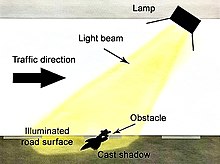
Light pollution is the presence of unwanted, inappropriate, or excessive artificial lighting. In a descriptive sense, the term light pollution refers to the effects of any poorly implemented lighting, during the day or night. Light pollution can be understood not only as a phenomenon resulting from a specific source or kind of pollution, but also as a contributor to the wider, collective impact of various sources of pollution.

A microscope is a laboratory instrument used to examine objects that are too small to be seen by the naked eye. Microscopy is the science of investigating small objects and structures using a microscope. Microscopic means being invisible to the eye unless aided by a microscope.

The lux is the unit of illuminance, or luminous flux per unit area, in the International System of Units (SI). It is equal to one lumen per square metre. In photometry, this is used as a measure of the intensity, as perceived by the human eye, of light that hits or passes through a surface. It is analogous to the radiometric unit watt per square metre, but with the power at each wavelength weighted according to the luminosity function, a model of human visual brightness perception, standardized by the CIE and ISO. In English, "lux" is used as both the singular and plural form. The word is derived from the Latin word for "light", lux.

A tunnel is an underground passageway, dug through surrounding soil, earth or rock, and enclosed except for the entrance and exit, commonly at each end. A pipeline is not a tunnel, though some recent tunnels have used immersed tube construction techniques rather than traditional tunnel boring methods.

Film speed is the measure of a photographic film's sensitivity to light, determined by sensitometry and measured on various numerical scales, the most recent being the ISO system introduced in the mid-1970s. A closely related ISO system is used to describe the relationship between exposure and output image lightness in digital cameras. Prior to ISO gaining traction the best known systems were ASA in the U.S. and DIN in Europe.

A headlamp is a lamp attached to the front of a vehicle to illuminate the road ahead. Headlamps are also often called headlights, but in the most precise usage, headlamp is the term for the device itself and headlight is the term for the beam of light produced and distributed by the device.

A warning sign is a type of sign which indicates a potential hazard, obstacle, or condition requiring special attention. Some are traffic signs that indicate hazards on roads that may not be readily apparent to a driver.
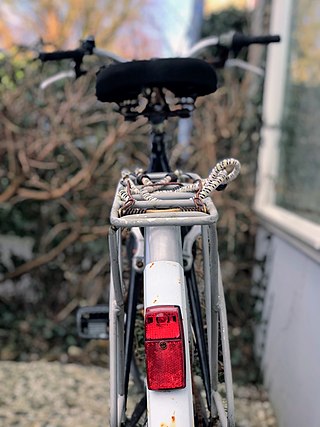
Bicycle lighting is illumination attached to bicycles whose purpose above all is, along with reflectors, to improve the visibility of the bicycle and its rider to other road users under circumstances of poor ambient illumination. A secondary purpose is to illuminate reflective materials such as cat's eyes and traffic signs. A third purpose may be to illuminate the roadway so that the rider can see the way ahead. Serving the latter purposes require much more luminous flux and thus more power.

The stroboscopic effect is a visual phenomenon caused by aliasing that occurs when continuous rotational or other cyclic motion is represented by a series of short or instantaneous samples at a sampling rate close to the period of the motion. It accounts for the "wagon-wheel effect", so-called because in video, spoked wheels sometimes appear to be turning backwards.
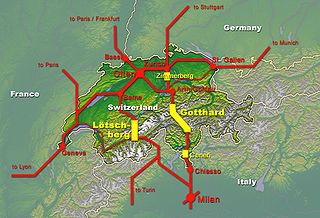
The New Railway Link through the Alps, is a Swiss construction project for faster north–south rail links across the Swiss Alps. It consists of two axes with several improvements along these rails including three new base tunnels several hundred metres below the existing apex tunnels, the 57-kilometre (35 mi) Gotthard Base Tunnel, the 35-kilometre (22 mi) Lötschberg Base Tunnel, and the 15-kilometre (9.3 mi) Ceneri Base Tunnel. Swiss Federal Railways subsidiary AlpTransit Gotthard AG and BLS AG subsidiary BLS Alp Transit AG were founded for this project and built the tunnels.
The visibility is the measure of the distance at which an object or light can be clearly discerned. In meteorology it depends on the transparency of the surrounding air and as such, it is unchanging no matter the ambient light level or time of day. It is reported within surface weather observations and METAR code either in meters or statute miles, depending upon the country. Visibility affects all forms of traffic: roads, railways, sailing and aviation.

A motor vehicle has lighting and signaling devices mounted to or integrated into its front, rear, sides, and, in some cases, top. The devices illuminate the road ahead for the driver and increase the vehicle's visibility, allowing other drivers and pedestrians to see its presence, position, size, direction of travel, and its driver's intentions.

The Eastern Distributor is a 4.7-kilometre-long (2.9 mi) motorway in Sydney, New South Wales, Australia. Part of the M1, the motorway links the Sydney central business district with the south-east and Sydney Airport. The Eastern Distributor separates Sydney's Eastern Suburbs from Sydney's Inner-Southern Suburbs. The centre-piece is a 1.7 km (1.1 mi) tunnel running from Woolloomooloo to Surry Hills. Built as a build-own-operate-transfer project, it is 75.1% owned by Transurban.

Terrain cartography or relief mapping is the depiction of the shape of the surface of the Earth on a map, using one or more of several techniques that have been developed. Terrain or relief is an essential aspect of physical geography, and as such its portrayal presents a central problem in cartographic design, and more recently geographic information systems and geovisualization.
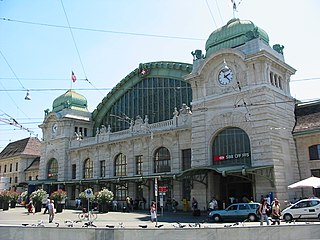
Basel SBB railway station is the central railway station in the city of Basel, Switzerland. Opened in 1854, and completely rebuilt in 1900–1907, it is Europe's busiest international border station. Basel SBB is owned by the Swiss Federal Railways (SBB CFF FFS). The other major railway station is Basel Badischer Bahnhof, operated by the German railway company Deutsche Bahn, on the north side of the Rhine from the city centre.

Implenia is a Swiss real estate and construction services company with activities in development and civil engineering in Switzerland and Germany. Implenia is also active in tunnelling and related infrastructure construction in Austria, France, Sweden, Norway and Italy. The Group was formed at the beginning of 2006 from the merger of Basel-based Batigroup Holding AG with Geneva-based Zschokke Holding SA. The headquarters are located in Glattpark (Opfikon) in the canton of Zurich. Implenia is one of the 500 largest companies in Switzerland.
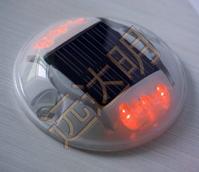
Solar road studs are flashing solar cell powered LED low-maintenance lighting devices that delineate road edges and centrelines. Embedded in the road surface, they are an electronic improvement on the traditional cat's eyes and raised pavement marker in that they may give drivers a larger reaction window.

Quaibrücke is a road, tramway, pedestrian and bicycle bridge over the river Limmat, at the outflow of Lake Zürich in the city of Zürich, Switzerland. It was built simultaneously with the construction of Zürich's new quays between 1881 and 1887.

Tunnels are dug in types of materials varying from soft clay to hard rock. The method of tunnel construction depends on such factors as the ground conditions, the ground water conditions, the length and diameter of the tunnel drive, the depth of the tunnel, the logistics of supporting the tunnel excavation, the final use and shape of the tunnel and appropriate risk management. Tunnel construction is a subset of underground construction.
In civil engineering, clearance refers to the difference between the loading gauge and the structure gauge in the case of railroad cars or trams, or the difference between the size of any vehicle and the width/height of doors, the width/height of an overpass or the diameter of a tunnel as well as the air draft under a bridge, the width of a lock or diameter of a tunnel in the case of watercraft. In addition, there is the difference between the deep draft and the stream bed or sea bed of a waterway.
